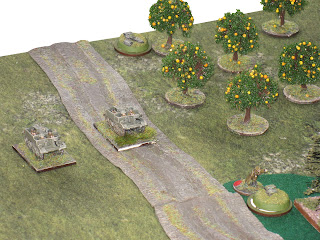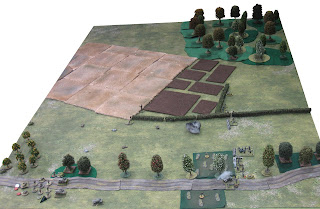Capturing Caesar's Camp, 3rd June 1940 - a pint-sized campaign
Finally, after all our practise games and familiarisation with the new, 2nd Edition, Chain of Command rules, John and I finally kicked off our campaign for real. As we were both politely offering each other the chance to choose sides, John's wife broke the deadlock by rolling a d6, and duly appointed John as the British commander (or should that be allies?) and me as the Boche.
Scenario 1 - 'Attack on Hedgehog Wood'
The first scenario, see map below, is a delaying action by the Germans.
As I couldn't get far enough away from the table in my bijou cabinette to take a photo of the whole table from the British side, as in the map above, I had to settle for one taken from the right hand, or eastern, edge. The knocked-out Dingo scout car can be seen in the bottom right of the photo - this was the scenario objective.
I don't know where the trees for the small copse (green felt template at bottom left of the photo) went when I took the photo but they were there when we started playing. Anyway, the dice rolls for Force Morale saw the Germans supremely confident on 11, while the British were a little less sure of themselves on only 9.
Both sides needed to get possession of the Dingo ...... to recover important papers left inside. Possession of these papers gains either side a full CoC die at the start of Scenario 3, but the British are really up against it to get there before the Germans.
As a result of the placement of the objective (Dingo), both sides concentrated their Patrol Phase activity along the road to get as close as possible to the scout car. The Brits get 1-3 three moves before the patrol phase proper starts. However, John threw a '1' and only got one move before the Germans, courtesy of their higher Force Morale started the patrol phase proper. As a result, the British Jump Off Points (JOPs) were all clustered around where the road entered their table edge (note the copse now complete with trees!).
The German JOPs were strung out in a line, with two taking advantage of the hedges and one placed within deployment distance of the Dingo, courtesy of the scenario specific rule allowing the Germans to place one JOP anywhere in their deployment zone regardless of patrol marker locations.
Now, the question of what support to procure with my 8 points (the Brits get 12). It seemed fairly obvious that the Brits would go for a Pre-Game Barrage as it represented their best chance to rush the objective before I could seize it; any such rush if successful would most likely also shut down my JOP placed near the objective so, what would I need to stop this? MINES!
With my remaining points I selected: an le.IG 18 7.5cm infantry gun with junior leader (Jnr Ldr) and five crew (4pts); and, two entrenchments for a single team (1pt each), for a grand total of 8 support points.
Now it was my first phase, and unsurprisingly I chose to deploy a section with an entrenchment at the Dingo objective (the Rifle team in an entrenchment and the LMG team using the Dingo for cover). What was more surprising was that, despite the pre-game barrage, the section deployed, tactically, without any trouble, as did one of my senior leaders, although the supporting 7.5cm infantry gun team didn't show up.
Lacking a '1' in their command dice, to deploy their 7.5cm gun[1], the Germans thought it best to just sit tight, and tactical, in their hard cover. Besides, spending a full, unpinned, phase in possession of the Dingo wreck would gain them the papers and the full CoC die for Scenario 3.
With some better command dice, John, anxious to restore some momentum to his attack, deployed one of his infantry sections and a Dingo scout car that also opened fire with its Bren.
In return I now fielded another section (with one entrenchment for the LMG team and the Rifle team taking cover behind a hedge to my right - no photo) who opened fire managing to kill one infantryman. My 7.5cm gun also attempted to deploy but failed, again.
The Brits now started a steady advance, supported by the deployment of another 2" mortar team, towards the German section by the Dingo wreck, firing as they went but frustratingly again failing to inflict any casualties.
The latest British advance had brought their Dingo within close range of the first German section so, after any shock had been rallied off, my LMG attempted to drive it off - it failed. I also, FINALLY, managed to deploy the 7.5cm gun which attempted to target the infantry advancing in the open behind the armour killing one man but inflicting no shock.








































